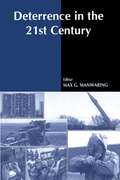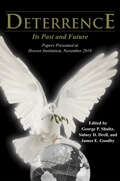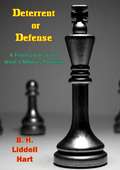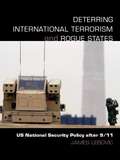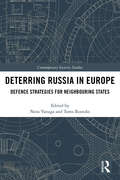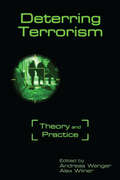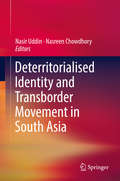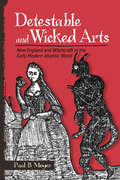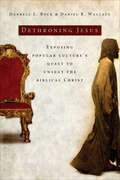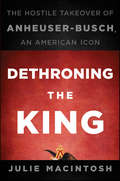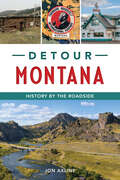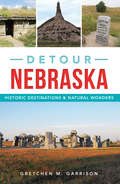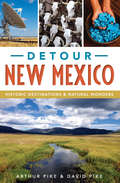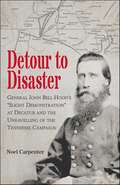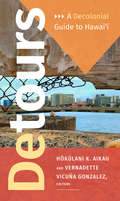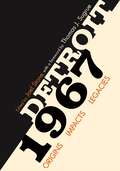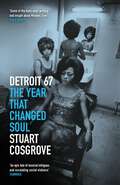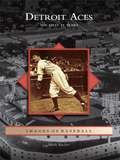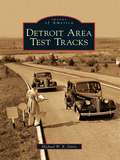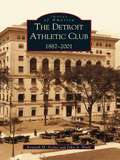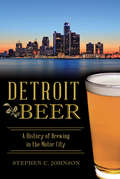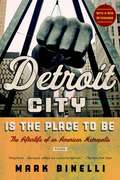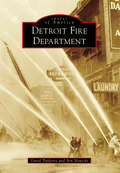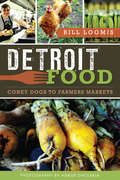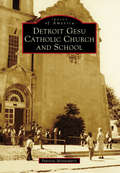- Table View
- List View
Deterrence in the Twenty-first Century
by Max G. ManwaringThis anthology argues that facing the diverse threats in the 'new world disorder' requires a new look and new approaches. The requirement is to establish that contemporary deterrence demands replacing the old 'nuclear theology' with new policy and strategy to deal with the myriad state, non-state, and trans-national nuclear and non-nuclear menaces that have heretofore been ignored or wished away.
Deterrence: Its Past and Future—Papers Presented at Hoover Institution, November 2010
by George P. Shultz James E. Goodby Sidney D. DrellDrawn from the third in a series of conferences the Hoover Institution at Stanford University on the nuclear legacy of the cold war, this report examines the importance of deterrence, from its critical function in the cold war to its current role. Recognizing that today's international environment is radically different from that which it was during the cold war, the need is pressing to reassess the role of nuclear weapons in deterrence in the world of today and to look ahead to the future.
Deterrent or Defense: A Fresh Look at the West’s Military Position
by B. H. Liddell HartHere is a much-needed assessment and summing-up on four current strategic situation by B. H. Liddell Hart, the leading military analyst of our time. Taking a clear, hard look at Western defense capabilities and strategic planning, particularly as they are embodied in NATO, he has come up with suggestions for radical but vital revisions in our defense policies.Fifteen years have elapsed since Captain Liddell Hart forecast the consequences of atom-bomb diplomacy. Now, as the NATO powers move uneasily forward in the 1960’s, he shows how the development of the H-bomb—and, indeed, the multiplication in general of nuclear weapons on both sides—has become on the one hand, increasingly self-inhibiting, and, on the other, increasingly precarious as a protective insurance policy, especially in view of the development of log-range missiles.The natural consequences of the current nuclear parity is nuclear nullity. Thus, the nuclear deterrent, in which the West has put so much trust, is fading except as a deterrent to its own kind of action. But the Western powers have not yet come to grips with the problem of finding an adequate and effective replacement for this “fading deterrent.” As a result, the West now finds itself gravely hampered in any attempt to resist the more subtle forms of aggression and pressure.Having carefully analyzed the ailment, the author offers a hopeful cure, demonstrating how the weakness of the West’s present position can be remedied without an intolerable outlay in strain and cost.
Deterring International Terrorism and Rogue States: US National Security Policy after 9/11 (Contemporary Security Studies)
by James H. LebovicThis new study challenges the widely held view that many current US adversaries cannot be deterred, maintaining that deterrence is not a relic of the Cold War period and that it should shape US policies toward so-called ‘rogue states’ and terror groups. James Lebovic argues that deterrence principles continue to apply, and focuses upon the ‘three pillars’ of the Bush administration’s national security policy: missile defence, which preoccupied the administration until September 11, 2001 pre-emption, which became the US focus with the September 11 attacks and US success in overthrowing the Taliban regime in Afghanistan homeland security, which the administration has portrayed as more a natural response to threat than an aspect of policy that must be reconciled with the other pillars. Deterring International Terrorism and Rogue States asserts that bad offences and defences have been endemic to the current US policy approach, leading US policy makers to pursue policies that require them to do everything without adequate concern for resource trade-offs, overreach, and unintended consequences. This book will be of great interest to students of US foreign policy, national and international security, terrorism and international relations in general.
Deterring Russia in Europe: Defence Strategies for Neighbouring States (Contemporary Security Studies)
by Nora Vanaga Toms RostoksThis edited volume examines deterrence and the defense efforts of European states neighboring Russia, following the Crimean intervention. Deterrence, after being largely absent from debates among academics and policy-makers for almost a quarter of a century, has made a comeback in Europe. Since Russia’s annexation of Crimea and the start of the military conflict in Ukraine’s Donbass region, eastern and northern European states have revised their assessments of Russia’s policies and intentions. The approach used by Russia in Ukraine has rendered lessons learned from the Cold War deterrence only partially applicable due to the changing security situation in Europe. The emergence of the cyber realm, a smaller emphasis on nuclear deterrence, and the ideological conflict between Russia and the West, are among the key differences between the Cold War and the current security environment. Structured into two parts, the first part discusses conceptual aspects of deterrence, while the second discusses ten country case studies, which include both NATO and non-NATO countries. This allows for an in-depth analysis of the changing character of deterrence and its practical application by Russia’s European neighbours. This volume will be of much interest to students of strategic studies, European politics, Russian foreign policy, security studies and international relations in general.
Deterring Terrorism: Theory and Practice
by Andreas Wenger Alex WilnerDuring the Cold War, deterrence theory was the cornerstone of U. S. foreign policy. Following the 9/11 terrorist attacks, however, popular wisdom dictated that terrorist organizations and radical fanatics could not be deterred-and governments shifted their attention to combating terrorism rather than deterring it. This book challenges that prevailing assumption and offers insight as to when and where terrorism can be deterred. It first identifies how and where theories of deterrence apply to counterterrorism, highlighting how traditional and less-traditional notions of deterrence can be applied to evolving terrorist threats. It then applies these theoretical propositions to real-world threats to establish the role deterrence has within a dynamic counterterrorism strategy-and to identify how metrics can be created for measuring the success of terrorism deterrence strategies. In sum, it provides a foundation for developing effective counterterrorism policies to help states contain or curtail the terrorism challenges they face.
Deterritorialised Identity and Transborder Movement in South Asia
by Nasreen Chowdhory Nasir UddinThis volume is about migration across South Asia and the complex negotiation of borders by people and the states in the process. A border is understood as a form of demarcation, but it also opens up the flow of people, goods, and ideas of legality and illegality. Borders are dynamic and dyadic in the interface of state and non-state actors involved in border operations. Consequently, transborder movement becomes a complex web involving concerns of security, trade, militancy, and questions of citizenship, along with discourses of ghettoisation, belonging and otherness. Since the mid-20th century, the South Asian region has witnessed growing social and political instability and breakdown of regional cooperation. In this context, the volume casts a wide, interdisciplinary lens across South Asia and discusses economic migration as well as forced migration due to persecution and natural disasters. It looks at how understandings of ‘territoriality’ and ‘border’ become blurred due to increasing transborder migration in the region: how states in South Asia address transborder movements at both policy level and on the ground; and how borderlands become spaces for illegal trade and informal economy in South Asia and for negotiations between states and refugees on identity and citizenship. This highly topical volume is for a wide group of scholars and students interested in South Asia, ranging from sociology, anthropology, political science, history, to interdisciplinary fields like migration studies, peace and conflict studies, and development studies.
Detestable and Wicked Arts: New England and Witchcraft in the Early Modern Atlantic World
by Paul B. MoyerIn Detestable and Wicked Arts, Paul B. Moyer places early New England's battle against black magic in a transatlantic perspective. Moyer provides an accessible and comprehensive examination of witch prosecutions in the Puritan colonies that discusses how their English inhabitants understood the crime of witchcraft, why some people ran a greater risk of being accused of occult misdeeds, and how gender intersected with witch-hunting. Focusing on witchcraft cases in New England between roughly 1640 and 1670, Detestable and Wicked Arts highlights ties between witch-hunting in the New and Old Worlds. Informed by studies on witchcraft in early modern Europe, Moyer presents a useful synthesis of scholarship on occult crime in New England and makes new and valuable contributions to the field.
Dethroning Jesus: Exposing Popular Culture's Quest to Unseat the Biblical Christ
by Darrell L. Bock Daniel B. WallaceNew York Times bestselling author Dr. Darrell Bock teams up with Dr. Daniel Wallace to help you separate fact from fiction among constant attacks on Christianity from popular culture and bogus scholars.There is a quest going on to reduce Jesus to a mythic legend or to nothing more than a mere man. Scholars such as Elaine Pagels and James Tabor are using recent discoveries like the Gospel of Judas and the Gospel of Thomas to argue that the Christ of Christianity is a contrived figure and that a different Christ—one human and not divine—is the "true" Christ.Both research professors, Bock and Wallace set out a vigorous defense of Christianity against a popular trend that they dub "Jesusanity", where Christ was simply a human teacher. In their trademark, easy-to-understand style, the authors take on attempts to redefine Jesus in a convincing way that will help you understand that the orthodox understanding of Christ and his divinity is as trustworthy and sure as it ever was. This book:Refutes the six main claims that represent a large part of skepticism about Jesus todayProvides credible answers to attacks on the traditional textsDefends against the interpretations of bogus scholars and the arguments of biased scholarsConstructs a positive case for the Jesus of faithIf you&’re exhausted by the constant attempts to dethrone Jesus, renew the security of your knowledge of who Jesus really is: the Son of God.
Dethroning the King
by Julie MacintoshHow the King of Beers collapsed without a fight and what it means for America's place in the post-Recession worldHow did InBev, a Belgian company controlled by Brazilians, take over one of America's most beloved brands with scarcely a whimper of opposition? Chalk it up to perfect timing--and some unexpected help from powerful members of the Busch dynasty, the very family that had run the company for more than a century. In Dethroning the King, Julie MacIntosh, the award-winning financial journalist who led coverage of the takeover for the Financial Times, details how the drama that unfolded at Anheuser-Busch in 2008 went largely unreported as the world tumbled into a global economic crisis second only to the Great Depression. Today, as the dust settles, questions are being asked about how the "King of Beers" was so easily captured by a foreign corporation, and whether the company's fall mirrors America's dwindling financial and political dominance as a nation.Discusses how the takeover of Anheuser-Busch will be seen as a defining moment in U.S. business historyReveals the critical missteps taken by the Busch family and the Anheuser-Busch boardArgues that Anheuser-Busch had a chance to save itself from InBev's clutches, but infighting and dysfunctionality behind the scenes forced it to capitulateFrom America's heartland to the European continent to Brazil, Dethroning the King is the ultimate corporate caper and a fascinating case study that's both wide reaching and profound.
Detour Montana: History by the Roadside
by Jon AxlineTraveling through Time While Montana's roadside historical markers give motorists an introduction to the state's colorful history, there's much more to explore. Priests Pass and Helena's Morelli Bridge were displays of ambition and fortitude. Conversely, the story The Black and White Trail represents the folly of one Doc Siegfriedt. Once thriving and strategically located along rails and roads, the towns of Beaverton and Taft are lost to history. While striking geological features like Tower Rock and picturesque byways like Harding Way are enduring vistas. Historian Jon Axline takes readers along the aboriginal trails, territorial roads, historic bridges and fascinating stopping points connected to Montana's lively and exciting transportation history.
Detour Nebraska: Historic Destinations & Natural Wonders
by Gretchen M. GarrisonFor many, Nebraska is the flat prairie seen from the interstate. Yet with the Sandhills, bluffs and river valleys, the state has an abundance of riches. The heritage of early settlers is evident. Fort Kearny and Chimney Rock were pioneer harbors. The Fur Trade Museum and the Homestead Monument of America tell of those who came to make a life. Carhenge is a nationally known treasure. The Joslyn Art Museum features world-class art, and the Nebraska National Forest is the largest hand-planted forest in the nation. Native Nebraskan Gretchen Garrison details the places and people that make the Cornhusker State unique.
Detour New Mexico: Historic Destinations & Natural Wonders
by Arthur Pike David PikeNew Mexico’s rich and varied history is easily accessible via detours down obscure backroads and overlooked off-ramps. By taking the road less traveled in any direction, visitors can experience ancient landmarks, cultural heritage sites and striking vistas. Stop at places along the old Route 66, sample the world’s best chiles by the Rio Grande or soak in geothermal water flowing under Truth or Consequences. Ancient dwellings in remote canyons, the town where the first atomic bomb was secretly assembled and the grave of Billy the Kid all lie off the beaten path in the Land of Enchantment. Authors Arthur and David Pike map out these and many more worthwhile points of interest for the curious traveler.
Detour to Disaster: General John Bell Hood's "Slight Demonstration" at Decatur and the Unraveling of the Tennessee Campaign
by Noel CarpenterA detailed account of the pivotal decision made by a young army commander to march to Decatur, and the consequential combat that ensued. In October of 1864, Confederate General John Bell Hood set out through Alabama on what would be the final campaign of the Army of Tennessee. One event in particular, overlooked and misunderstood for generations, portended what was to follow and is the subject of Noel Carpenter’s Detour to Disaster: General John Bell Hood’s “Slight Demonstration” at Decatur and the Unravelling of the Tennessee Campaign. In this fascinating and meticulously detailed and documented account—the first book-length study of the weighty decision to march to Decatur and the combat that followed there—Carpenter investigates the circumstances surrounding these matters and how they overwhelmed the controversial young army commander and potentially doomed his daring invasion. Detour to Disaster is required reading for everyone interested in the Western Theater, and especially the doomed Tennessee Campaign.
Detours: A Decolonial Guide to Hawai'i
by Hokulani K. Aikau Vernadette Vicuna GonzalezMany people first encounter Hawai&‘i through the imagination—a postcard picture of hula girls, lu&‘aus, and plenty of sun, surf, and sea. While Hawai&‘i is indeed beautiful, Native Hawaiians struggle with the problems brought about by colonialism, military occupation, tourism, food insecurity, high costs of living, and climate change. In this brilliant reinvention of the travel guide, artists, activists, and scholars redirect readers from the fantasy of Hawai&‘i as a tropical paradise and tourist destination toward a multilayered and holistic engagement with Hawai&‘i's culture and complex history. The essays, stories, artworks, maps, and tour itineraries in Detours create decolonial narratives in ways that will forever change how readers think about and move throughout Hawai&‘i. Contributors. Hōkūlani K. Aikau, Malia Akutagawa, Adele Balderston, Kamanamaikalani Beamer, Ellen-Rae Cachola, Emily Cadiz, Iokepa Casumbal-Salazar, David A. Chang, Lianne Marie Leda Charlie, Greg Chun, Joy Lehuanani Enomoto, S. Joe Estores, Nicholas Kawelakai Farrant, Jessica Ka&‘ui Fu, Candace Fujikane, Linda H. L. Furuto, Sonny Ganaden, Cheryl Geslani, Vernadette Vicuña Gonzalez, Noelani Goodyear-Ka&‘ōpua, Tina Grandinetti, Craig Howes, Aurora Kagawa-Viviani, Noelle M. K. Y. Kahanu, Haley Kailiehu, Kyle Kajihiro, Halena Kapuni-Reynolds, Terrilee N. Kekoolani-Raymond, Kekuewa Kikiloi, William Kinney, Francesca Koethe, Karen K. Kosasa, N. Trisha Lagaso Goldberg, Kapulani Landgraf, Laura E. Lyons, David Uahikeaikalei&‘ohu Maile, Brandy Nālani McDougall, Davianna Pōmaika&‘i McGregor, Laurel Mei-Singh, P. Kalawai&‘a Moore, Summer Kaimalia Mullins-Ibrahim, Jordan Muratsuchi, Hanohano Naehu, Malia Nobrega-Olivera, Katrina-Ann R. Kapā&‘anaokalāokeola Nākoa Oliveira, Jamaica Heolimelekalani Osorio, No&‘eau Peralto, No&‘u Revilla, Kalaniua Ritte, Maya L. Kawailanaokeawaiki Saffery, Dean Itsuji Saranillio, Noenoe K. Silva, Ty P. Kāwika Tengan, Stephanie Nohelani Teves, Stan Tomita, Mehana Blaich Vaughan, Wendy Mapuana Waipā, Julie Warech
Detroit 1967: Origins, Impacts, Legacies (Painted Turtle)
by Thomas J. Sugrue Joel StoneIn the summer of 1967, Detroit experienced one of the worst racially charged civil disturbances in United States history. Years of frustration generated by entrenched and institutionalized racism boiled over late on a hot July night. In an event that has been called a “riot,” “rebellion,” “uprising,” and “insurrection,” thousands of African Americans took to the street for several days of looting, arson, and gunfire. Law enforcement was overwhelmed, and it wasn’t until battle-tested federal troops arrived that the city returned to some semblance of normalcy. Fifty years later, native Detroiters cite this event as pivotal in the city’s history, yet few completely understand what happened, why it happened, or how it continues to affect the city today. Discussions of the events are often rife with misinformation and myths, and seldom take place across racial lines. It is editor Joel Stone’s intention with Detroit 1967: Origins, Impacts, Legacies to draw memories, facts, and analysis together to create a broader context for these conversations. In order to tell a more complete story, Detroit 1967 starts at the beginning with colonial slavery along the Detroit River and culminates with an examination of the state of race relations today and suggestions for the future. Readers are led down a timeline that features chapters discussing the critical role that unfree people played in establishing Detroit, the path that postwar manufacturers within the city were taking to the suburbs and eventually to other states, as well as the widely held untruth that all white people wanted to abandon Detroit after 1967. Twenty contributors, from journalists like Tim Kiska, Bill McGraw, and Desiree Cooper to historians like DeWitt S. Dykes, Danielle L. McGuire, and Kevin Boyle, have individually created a rich body of work on Detroit and race, that is compiled here in a well-rounded, accessible volume. Detroit 1967 aims to correct fallacies surrounding the events that took place and led up to the summer of 1967 in Detroit, and to encourage informed discussion around this topic. Readers of Detroit history and urban studies will be drawn to and enlightened by these powerful essays.
Detroit 67: The Year That Changed Soul (The Soul Trilogy #1)
by Stuart CosgroveFirst in the award-winning soul music trilogy—featuring Motown artists Diana Ross & the Supremes, Smokey Robinson, Marvin Gaye, and others. Detroit 67 is &“a dramatic account of twelve remarkable months in the Motor City&” during the year that changed everything (Sunday Mail). It takes you on a turbulent journey through the drama and chaos that ripped through the city in 1967 and tore it apart in personal, political, and interracial disputes. It is the story of Motown, the breakup of the Supremes, and the damaging clashes at the heart of the most successful African American music label ever. Set against a backdrop of urban riots, escalating war in Vietnam, and police corruption, the book weaves its way through a year when soul music came of age and the underground counterculture flourished. LSD arrived in the city with hallucinogenic power, and local guitar band MC5—self-styled holy barbarians of rock—went to war with mainstream America. A summer of street-level rebellion turned Detroit into one of the most notorious cities on earth, known for its unique creativity, its unpredictability, and self-lacerating crime rates. The year 1967 ended in social meltdown, rancor, and intense legal warfare as the complex threads that held Detroit together finally unraveled. &“A whole-hearted evocation of people and places,&” Detroit 67 is &“a tale set at a fulcrum of American social and cultural history&” (Independent).
Detroit Aces: The First 75 Years (Images of Baseball)
by Mark RuckerEver since the city was granted its first major league team, the Wolverines in 1881, Detroit baseball fans have packed the parks to loyally cheer for their favorite hurlers on the mound. In 1887, Charlie Getzein, nicknamed "Pretzels," led the Detroit ball club to its first National League pennant with 29 wins. The rubber-armed "Wild" Bill Donovan led the Detroit Tigers to the city's first American League pennant in 1907, notching up an astounding .862 winning percentage despite a legendary lack of control. More great pitchers were to follow in the coming decades, and, written from the perspective of an old-time fan, Detroit Aces: The First 75 Years is a fun read for any Motor City baseball enthusiast.
Detroit Area Test Tracks (Images of America)
by Michael W. DavisThe catastrophic failure of a new but unproven copper-cooled Chevrolet in 1923 led the General Motors Corporation to buy back the 100 cars it had sold to the public and recall another 400 in company and dealer hands. As a result, in 1924 General Motors started building the industry's first scientific proving ground to test new vehicle designs before they were released for production and sale. Before this, all automakers tested new cars haphazardly on public roads and within limited engineering laboratories. Better known by the public as test tracks, the proving grounds became a source of curiosity for decades about the secrets they might hold. Detroit Area Test Tracks goes behind the test track walls to show how the facilities evolved and what typically takes place inside.
Detroit Athletic Club, The: 1887-2001 (Images of America)
by John A. Bluth Kenneth H. VoylesSince its establishment 114 years ago, the Detroit Athletic Club (DAC) has played a crucial role in the amazing history of the City of Detroit. Originally a club for amateur athletes, it was reorganized in 1913 by prominent automobile and industrial leaders. In that year, Albert Kahn, a renowned architect, designed the magnificent six-story clubhouse that still stands in the heart of Detroit's theatre and sports district.Beginning with the birth of the original club on Woodward Avenue in 1887, this book chronicles the history of the DAC up to the present, in over 200 vintage photographs-many never before seen outside of the club. Images gathered from the club's archives cover the formative years at the first club, the building and opening of the new club, the DAC's great athletic traditions, its membership and staff, social activities, the art of the DAC and its magnificent restoration at the end of the 20th century.
Detroit Beer: A History of Brewing in the Motor City (American Palate)
by Stephen C. JohnsonWhile in recent years Detroit's craft beer scene has exploded with activity and innovation, brewing has a long history in the Motor City. Small brewers popped up during the mid-1800s to support nearby saloons. Many breweries survived the dry years by producing "near beer," or non-alcoholic beer, which was quickly abandoned after Prohibition. Consolidation marked the following decades until only Stroh Brewery Company remained. Local brewing returned triumphantly with dozens of breweries opening their doors since the 1990s, including Motor City Brewing Works, Atwater Brewery and Kuhnhenn Brewing Company. Join author and Motor City Brew Tours founder Stephen Johnson for Detroit history by the pint.
Detroit City Is the Place to Be: The Afterlife of an American Metropolis
by Mark BinelliDetroit City Is the Place to Be is one of Publishers Weekly's Top 10 Best Books of 2012. Once America's capitalist dream town, Detroit is our country's greatest urban failure, having fallen the longest and the farthest--and, finally, into the largest municipal bankruptcy in U.S. history. Binelli does not shy away from exploring the violence, economic devastation, political corruption, and physical ruin that have ravaged his hometown, but he also offers a glimpse of a long-shot future: Detroit that is smaller, less segregated, greener, economically diverse, and better functioning--what could be the boldest reimagining of a postindustrial city in our new century.
Detroit Fire Department (Images of America)
by David Traiforos Arn NowickiOnce known as the "Paris of the West," Motown became synonymous with urban abandonment and arson as job and population decline took hold in the late 20th century. No other fire department has experienced the hardships of the job on such a consistent basis as the Detroit Fire Department (DFD). Detroit firefighters have ridden the waves of unprecedented prosperity and tragic decline. Determined faces mask many layoffs, station closings, and a reduction in workforce. Despite these perils, dedication and the belief in their city remains a constant among Detroit firefighters. The official Detroit motto, "We hope for better things; it shall rise from the ashes" holds as true today as it did when first uttered over 100 years ago.
Detroit Food: Coney Dogs to Farmers Markets (American Palate)
by Bill LoomisThe infamous images of Detroit's crumbling buildings, abandoned homes and weed-choked parks are known worldwide. Seldom shown are the city's thriving food ways, quietly rebuilding neighborhoods block by block with urban farms, locally made fare, new restaurants and an innovative, homegrown spirit that is attracting entrepreneurs and culinary enthusiasts from across the nation. Old neighborhoods are coming back to life with the smell of simmering soup, the crunch of new pickles and the aroma of all-day barbeque. Magnificent Art Deco clubs and speakeasies painstakingly restored to their former beauty are busy serving great local food. Author Bill Loomis goes behind the graffiti and ruins to explore how the passion for eating well is proving essential to Detroit's comeback..
Detroit Gesu Catholic Church and School (Images of America)
by Patricia MontemurriIn a reconfigured farmhouse just a mile outside of the city limits of Detroit, a Jesuit priest and 25 men, women, and children gathered to celebrate Sunday mass on March 19, 1922. The Reverend John McNichols named the Catholic mission church Gesu, the Italian word for �Jesus.� Gesu became one of Detroit�s landmark parishes. Its history illustrates the Motor City�s boom, bust, resilience, and resurgence. It was the home parish of four Detroit mayors, powerful members of Congress, auto industry titans, sports legends, artists, authors, and actors. At its peak in the mid-1960s, Gesu School enrolled 1,600 students. Because of Detroit�s decline and its racial and economic struggles, Gesu is one of only four Catholic elementary schools that remain in the city. But as Detroit rebounds, Gesu School is growing again.
